Survey Design for Servicescape and Consumer Perception in Boutique Restaurants
VerifiedAdded on 2022/11/01
|11
|2464
|155
AI Summary
This report presents a survey questionnaire for understanding the impact of servicescape on consumer perception in boutique restaurants. The questionnaire consists of both open-ended and close-ended questions and addresses factors like aesthetics, ambient factor, hygiene, exterior, tangibles, empathy and authenticity, and dining experience. The report also discusses the steps involved in effective questionnaire design.
Contribute Materials
Your contribution can guide someone’s learning journey. Share your
documents today.
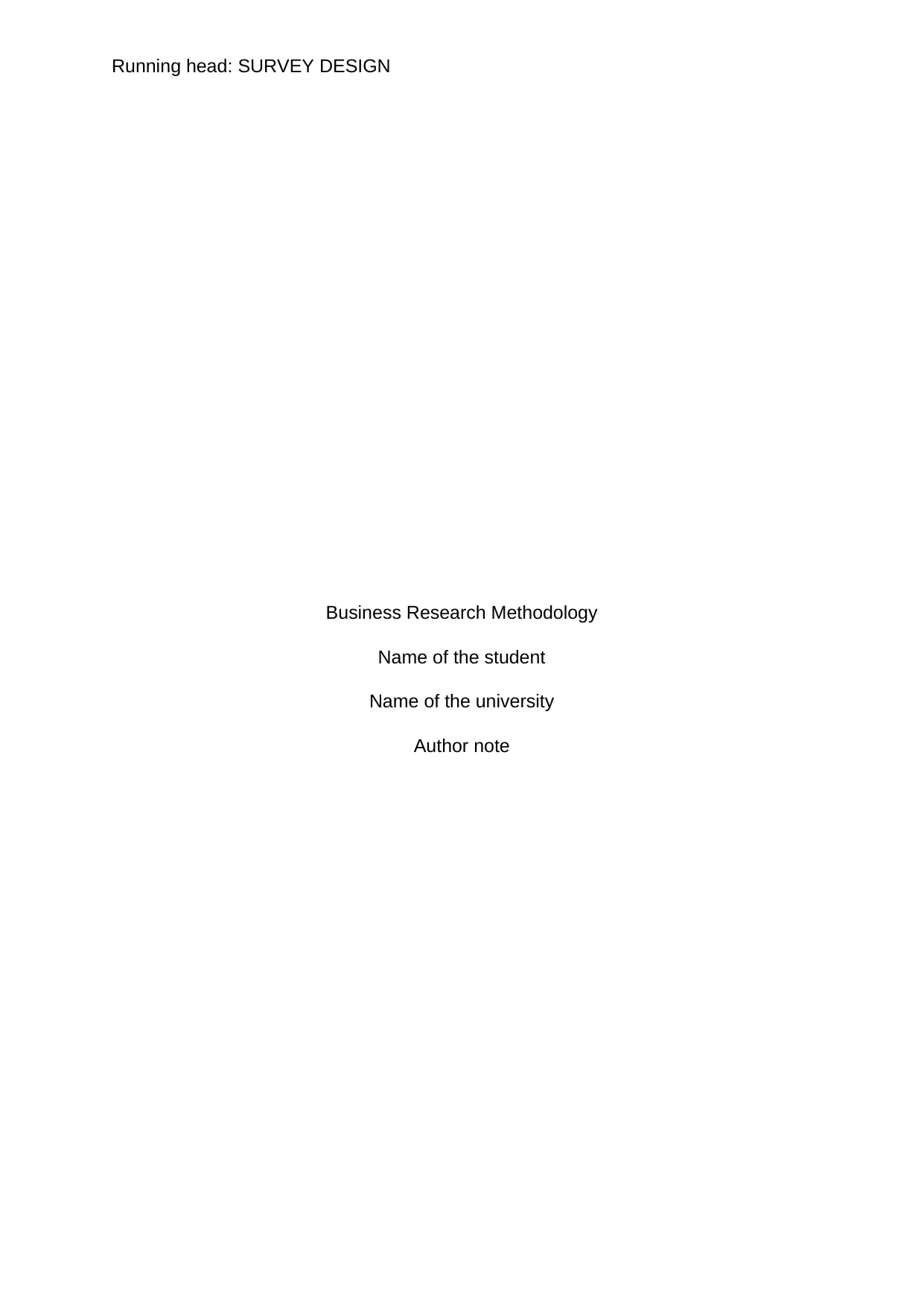
Running head: SURVEY DESIGN
Business Research Methodology
Name of the student
Name of the university
Author note
Business Research Methodology
Name of the student
Name of the university
Author note
Secure Best Marks with AI Grader
Need help grading? Try our AI Grader for instant feedback on your assignments.
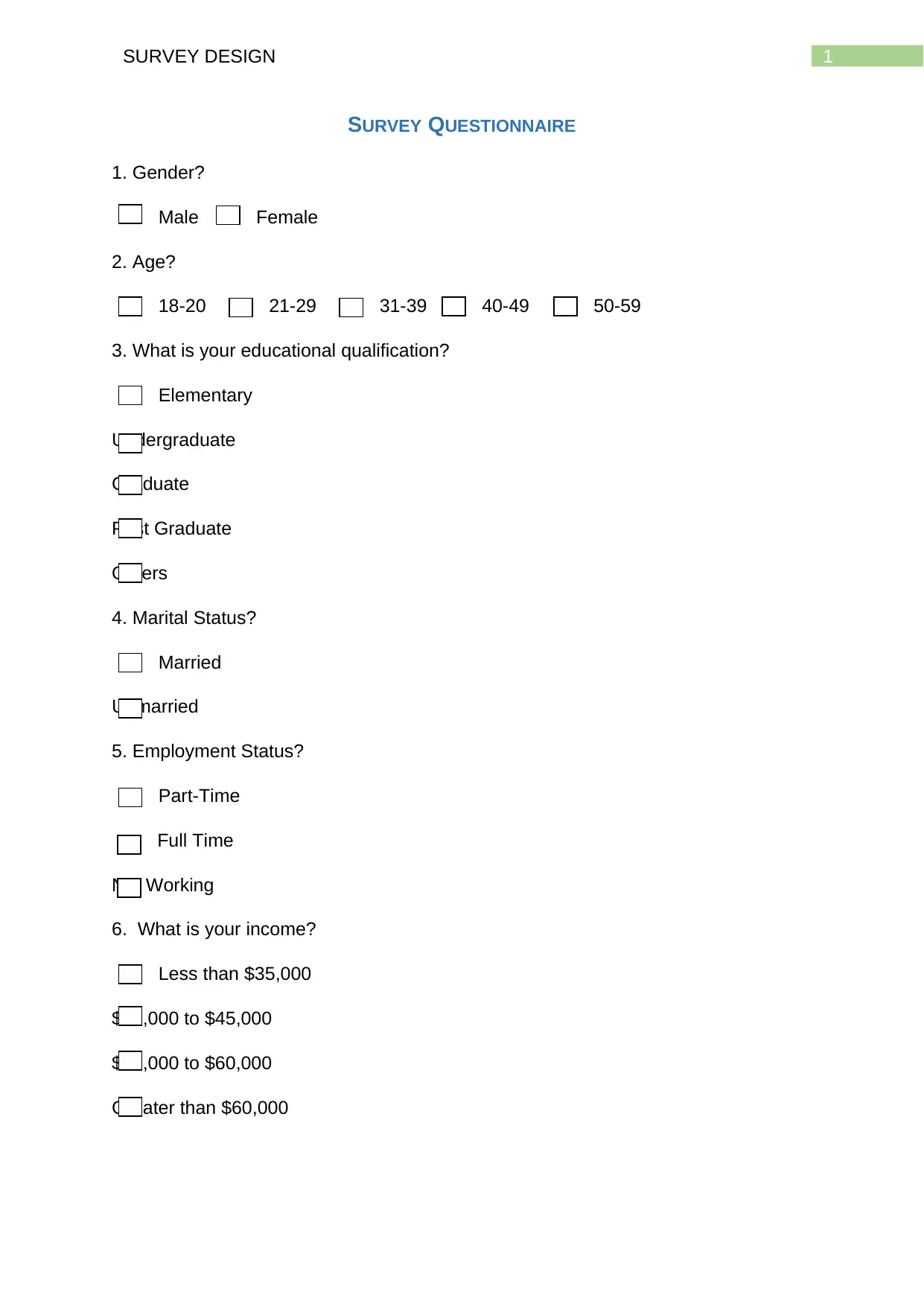
1SURVEY DESIGN
SURVEY QUESTIONNAIRE
1. Gender?
Male Female
2. Age?
18-20 21-29 31-39 40-49 50-59
3. What is your educational qualification?
Elementary
Undergraduate
Graduate
Post Graduate
Others
4. Marital Status?
Married
Unmarried
5. Employment Status?
Part-Time
Full Time
Not Working
6. What is your income?
Less than $35,000
$35,000 to $45,000
$46,000 to $60,000
Greater than $60,000
SURVEY QUESTIONNAIRE
1. Gender?
Male Female
2. Age?
18-20 21-29 31-39 40-49 50-59
3. What is your educational qualification?
Elementary
Undergraduate
Graduate
Post Graduate
Others
4. Marital Status?
Married
Unmarried
5. Employment Status?
Part-Time
Full Time
Not Working
6. What is your income?
Less than $35,000
$35,000 to $45,000
$46,000 to $60,000
Greater than $60,000

2SURVEY DESIGN
7. Kindly rate the following statement starting from 1-strongly agree, 2-agree, 3-
neutral, 4-disagree, and 5-strongly disagree.
Aesthetics 1 2 3 4 5
The architectural style of the hotel is attractive
Interior décor is visually appealing
Furniture is high quality
Natural elements are pleasant
Theme is reflected by the decor
8. Kindly rate the following statement starting from 1-strongly agree, 2-agree, 3-
neutral, 4-disagree, and 5-strongly disagree.
Ambient factor 1 2 3 4 5
Temperature is perfect
Aroma is enticing
Acceptable noise level
Good Air quality
Warm atmosphere is created by the colours
Appropriate lighting in Restaurants
Lighting gives a welcoming vibe
Lighting in restaurant is appropriate
9. Kindly rate the following statement starting from 1-strongly agree, 2-agree, 3-
neutral, 4-disagree, and 5-strongly disagree.
Hygiene 1 2 3 4 5
Dining areas are clean
Restrooms are clean
Exits and Walkways are clean
Easy layout for moving
Comfortable seating arrangements
7. Kindly rate the following statement starting from 1-strongly agree, 2-agree, 3-
neutral, 4-disagree, and 5-strongly disagree.
Aesthetics 1 2 3 4 5
The architectural style of the hotel is attractive
Interior décor is visually appealing
Furniture is high quality
Natural elements are pleasant
Theme is reflected by the decor
8. Kindly rate the following statement starting from 1-strongly agree, 2-agree, 3-
neutral, 4-disagree, and 5-strongly disagree.
Ambient factor 1 2 3 4 5
Temperature is perfect
Aroma is enticing
Acceptable noise level
Good Air quality
Warm atmosphere is created by the colours
Appropriate lighting in Restaurants
Lighting gives a welcoming vibe
Lighting in restaurant is appropriate
9. Kindly rate the following statement starting from 1-strongly agree, 2-agree, 3-
neutral, 4-disagree, and 5-strongly disagree.
Hygiene 1 2 3 4 5
Dining areas are clean
Restrooms are clean
Exits and Walkways are clean
Easy layout for moving
Comfortable seating arrangements
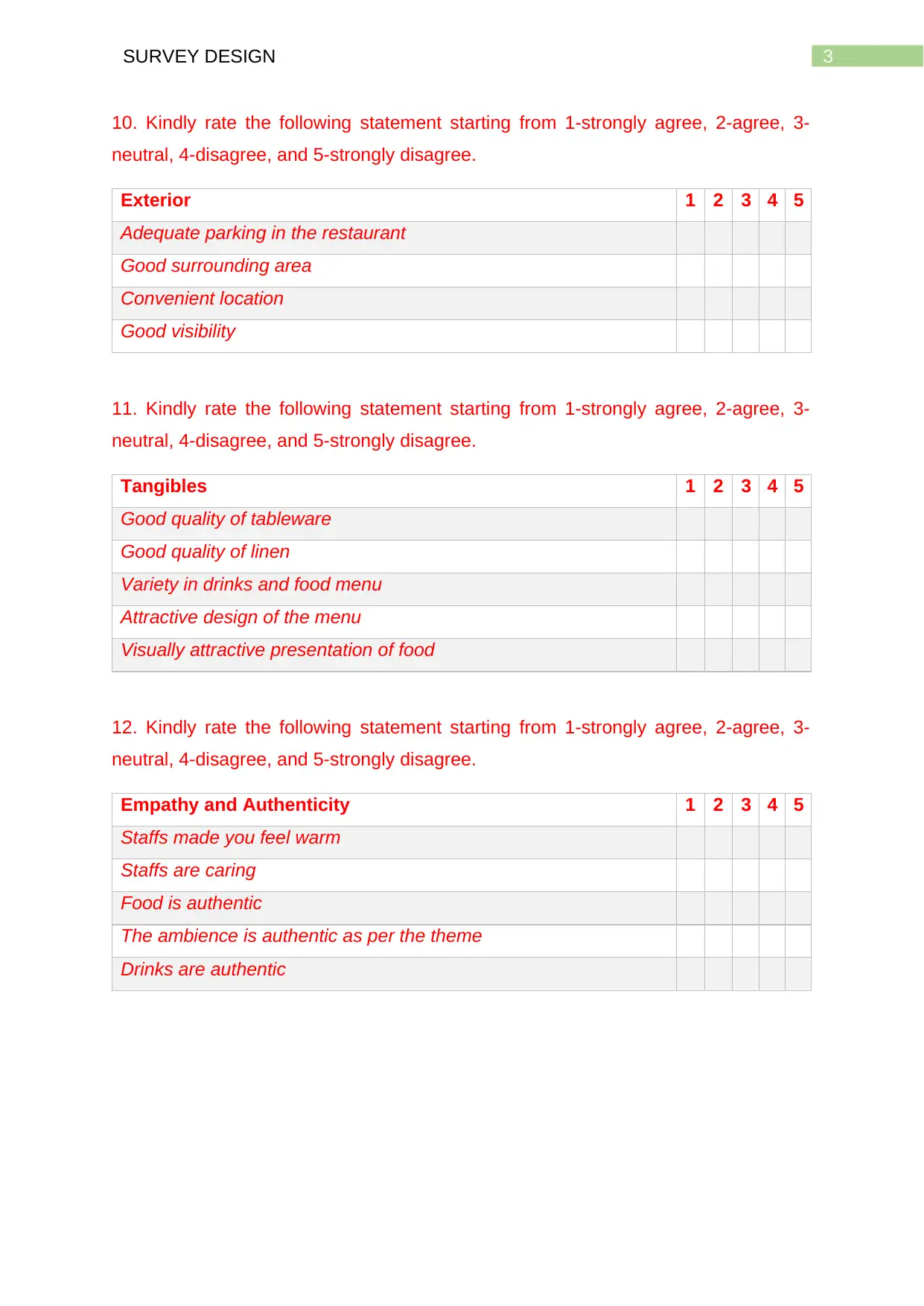
3SURVEY DESIGN
10. Kindly rate the following statement starting from 1-strongly agree, 2-agree, 3-
neutral, 4-disagree, and 5-strongly disagree.
Exterior 1 2 3 4 5
Adequate parking in the restaurant
Good surrounding area
Convenient location
Good visibility
11. Kindly rate the following statement starting from 1-strongly agree, 2-agree, 3-
neutral, 4-disagree, and 5-strongly disagree.
Tangibles 1 2 3 4 5
Good quality of tableware
Good quality of linen
Variety in drinks and food menu
Attractive design of the menu
Visually attractive presentation of food
12. Kindly rate the following statement starting from 1-strongly agree, 2-agree, 3-
neutral, 4-disagree, and 5-strongly disagree.
Empathy and Authenticity 1 2 3 4 5
Staffs made you feel warm
Staffs are caring
Food is authentic
The ambience is authentic as per the theme
Drinks are authentic
10. Kindly rate the following statement starting from 1-strongly agree, 2-agree, 3-
neutral, 4-disagree, and 5-strongly disagree.
Exterior 1 2 3 4 5
Adequate parking in the restaurant
Good surrounding area
Convenient location
Good visibility
11. Kindly rate the following statement starting from 1-strongly agree, 2-agree, 3-
neutral, 4-disagree, and 5-strongly disagree.
Tangibles 1 2 3 4 5
Good quality of tableware
Good quality of linen
Variety in drinks and food menu
Attractive design of the menu
Visually attractive presentation of food
12. Kindly rate the following statement starting from 1-strongly agree, 2-agree, 3-
neutral, 4-disagree, and 5-strongly disagree.
Empathy and Authenticity 1 2 3 4 5
Staffs made you feel warm
Staffs are caring
Food is authentic
The ambience is authentic as per the theme
Drinks are authentic
Secure Best Marks with AI Grader
Need help grading? Try our AI Grader for instant feedback on your assignments.

4SURVEY DESIGN
13. Kindly rate the following statement starting from 1-strongly agree, 2-agree, 3-
neutral, 4-disagree, and 5-strongly disagree.
Dining Experience 1 2 3 4 5
You are satisfied with the overall service
You are satisfied with the overall ambience
You are satisfied with the staffs' behaviour
You would recommend the restaurant to your friends and family
members
You would come back again
14. Are you satisfied with the services provided by the restaurant?
Yes
No, If no, Why? __________________________________________________
15. Rate your satisfaction level
Highly Satisfied
Satisfied
Somewhat Satisfied
Merely Satisfied
Unsatisfied
16. What is the deciding factor in choosing a restaurant?
___________________________________________________________________
17. Does external environment of the restaurant have any influence on the choice of
restaurant?
___________________________________________________________________
13. Kindly rate the following statement starting from 1-strongly agree, 2-agree, 3-
neutral, 4-disagree, and 5-strongly disagree.
Dining Experience 1 2 3 4 5
You are satisfied with the overall service
You are satisfied with the overall ambience
You are satisfied with the staffs' behaviour
You would recommend the restaurant to your friends and family
members
You would come back again
14. Are you satisfied with the services provided by the restaurant?
Yes
No, If no, Why? __________________________________________________
15. Rate your satisfaction level
Highly Satisfied
Satisfied
Somewhat Satisfied
Merely Satisfied
Unsatisfied
16. What is the deciding factor in choosing a restaurant?
___________________________________________________________________
17. Does external environment of the restaurant have any influence on the choice of
restaurant?
___________________________________________________________________
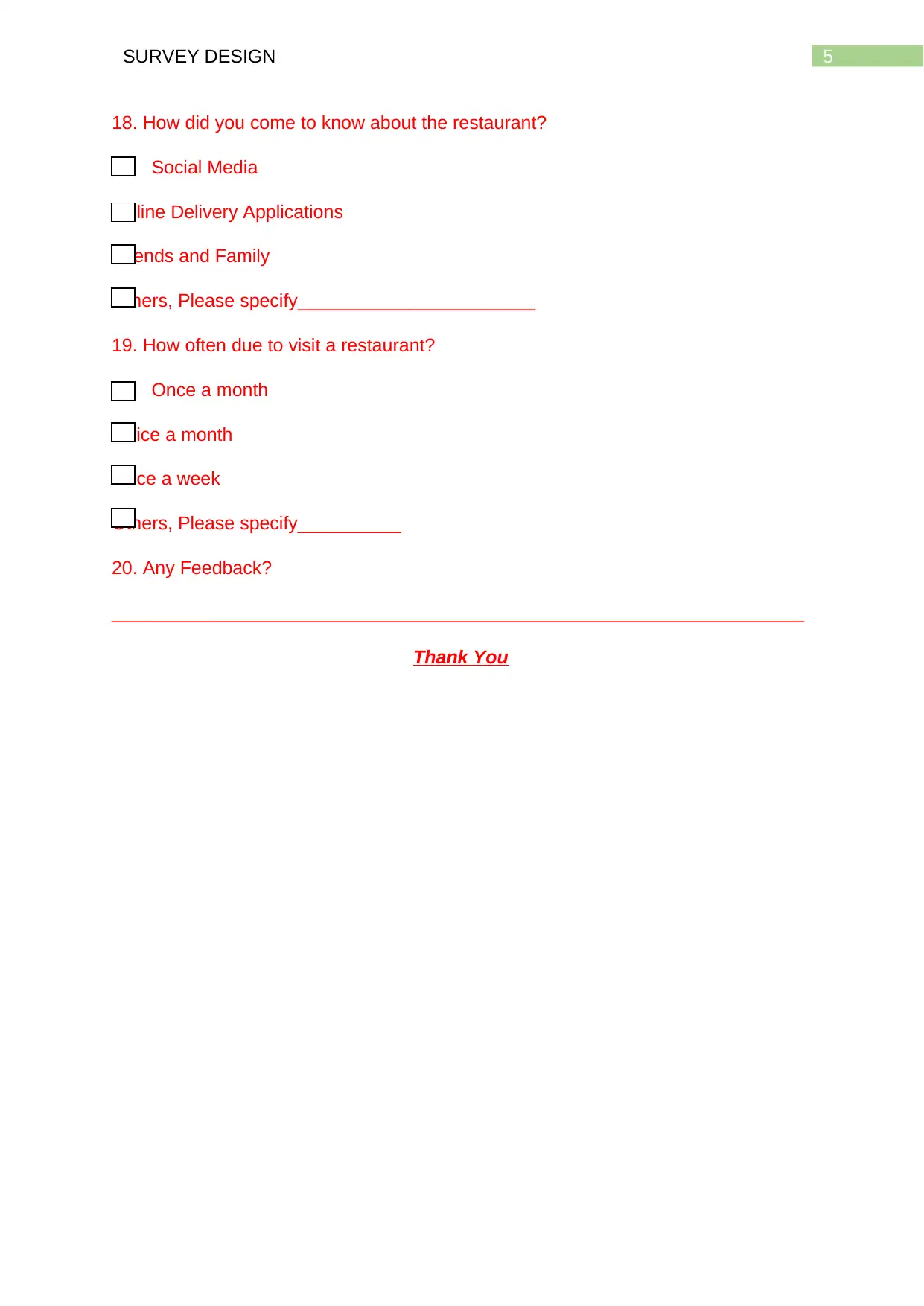
5SURVEY DESIGN
18. How did you come to know about the restaurant?
Social Media
Online Delivery Applications
Friends and Family
Others, Please specify_______________________
19. How often due to visit a restaurant?
Once a month
Twice a month
Once a week
Others, Please specify__________
20. Any Feedback?
___________________________________________________________________
Thank You
18. How did you come to know about the restaurant?
Social Media
Online Delivery Applications
Friends and Family
Others, Please specify_______________________
19. How often due to visit a restaurant?
Once a month
Twice a month
Once a week
Others, Please specify__________
20. Any Feedback?
___________________________________________________________________
Thank You
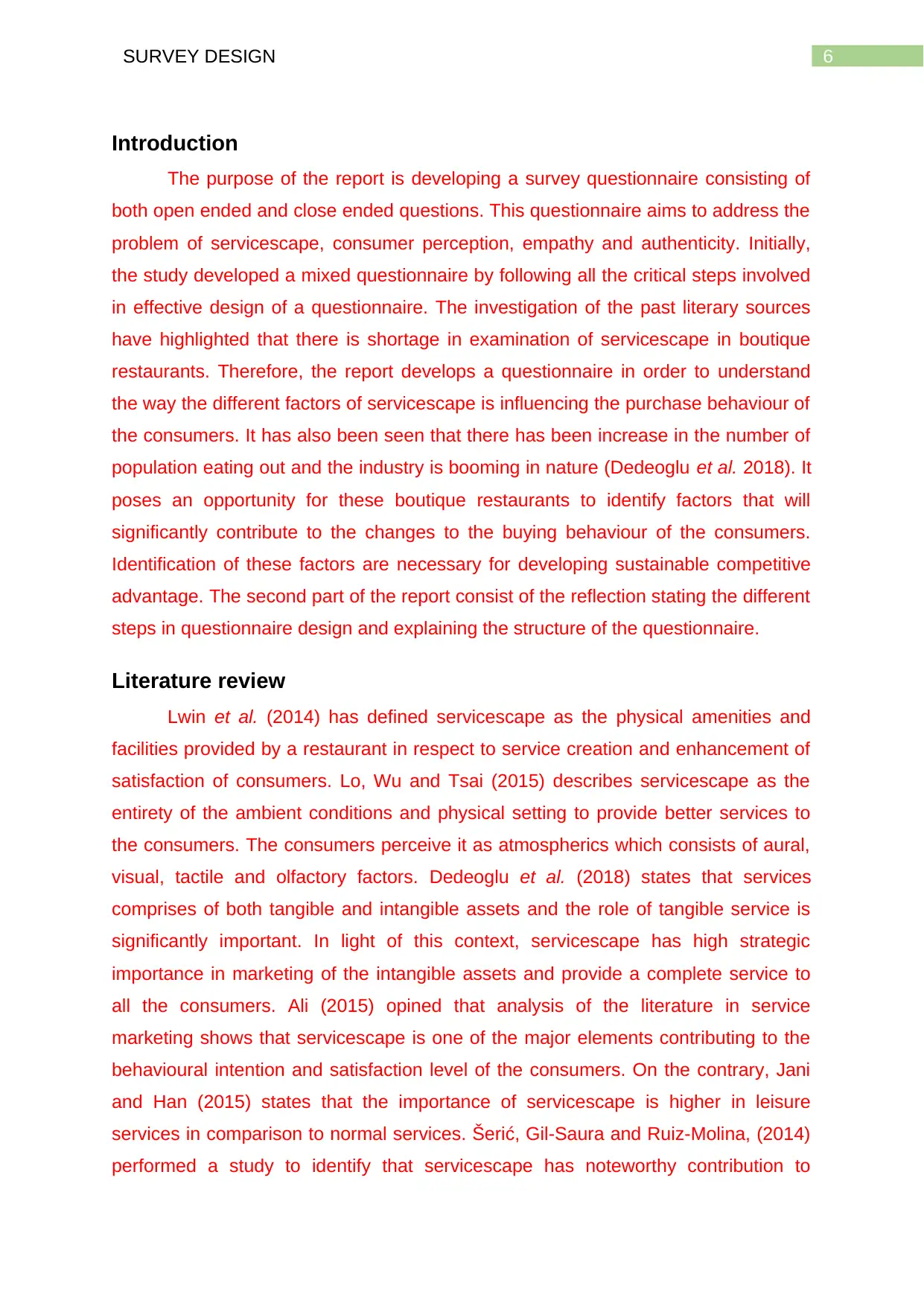
6SURVEY DESIGN
Introduction
The purpose of the report is developing a survey questionnaire consisting of
both open ended and close ended questions. This questionnaire aims to address the
problem of servicescape, consumer perception, empathy and authenticity. Initially,
the study developed a mixed questionnaire by following all the critical steps involved
in effective design of a questionnaire. The investigation of the past literary sources
have highlighted that there is shortage in examination of servicescape in boutique
restaurants. Therefore, the report develops a questionnaire in order to understand
the way the different factors of servicescape is influencing the purchase behaviour of
the consumers. It has also been seen that there has been increase in the number of
population eating out and the industry is booming in nature (Dedeoglu et al. 2018). It
poses an opportunity for these boutique restaurants to identify factors that will
significantly contribute to the changes to the buying behaviour of the consumers.
Identification of these factors are necessary for developing sustainable competitive
advantage. The second part of the report consist of the reflection stating the different
steps in questionnaire design and explaining the structure of the questionnaire.
Literature review
Lwin et al. (2014) has defined servicescape as the physical amenities and
facilities provided by a restaurant in respect to service creation and enhancement of
satisfaction of consumers. Lo, Wu and Tsai (2015) describes servicescape as the
entirety of the ambient conditions and physical setting to provide better services to
the consumers. The consumers perceive it as atmospherics which consists of aural,
visual, tactile and olfactory factors. Dedeoglu et al. (2018) states that services
comprises of both tangible and intangible assets and the role of tangible service is
significantly important. In light of this context, servicescape has high strategic
importance in marketing of the intangible assets and provide a complete service to
all the consumers. Ali (2015) opined that analysis of the literature in service
marketing shows that servicescape is one of the major elements contributing to the
behavioural intention and satisfaction level of the consumers. On the contrary, Jani
and Han (2015) states that the importance of servicescape is higher in leisure
services in comparison to normal services. Šerić, Gil-Saura and Ruiz-Molina, (2014)
performed a study to identify that servicescape has noteworthy contribution to
Introduction
The purpose of the report is developing a survey questionnaire consisting of
both open ended and close ended questions. This questionnaire aims to address the
problem of servicescape, consumer perception, empathy and authenticity. Initially,
the study developed a mixed questionnaire by following all the critical steps involved
in effective design of a questionnaire. The investigation of the past literary sources
have highlighted that there is shortage in examination of servicescape in boutique
restaurants. Therefore, the report develops a questionnaire in order to understand
the way the different factors of servicescape is influencing the purchase behaviour of
the consumers. It has also been seen that there has been increase in the number of
population eating out and the industry is booming in nature (Dedeoglu et al. 2018). It
poses an opportunity for these boutique restaurants to identify factors that will
significantly contribute to the changes to the buying behaviour of the consumers.
Identification of these factors are necessary for developing sustainable competitive
advantage. The second part of the report consist of the reflection stating the different
steps in questionnaire design and explaining the structure of the questionnaire.
Literature review
Lwin et al. (2014) has defined servicescape as the physical amenities and
facilities provided by a restaurant in respect to service creation and enhancement of
satisfaction of consumers. Lo, Wu and Tsai (2015) describes servicescape as the
entirety of the ambient conditions and physical setting to provide better services to
the consumers. The consumers perceive it as atmospherics which consists of aural,
visual, tactile and olfactory factors. Dedeoglu et al. (2018) states that services
comprises of both tangible and intangible assets and the role of tangible service is
significantly important. In light of this context, servicescape has high strategic
importance in marketing of the intangible assets and provide a complete service to
all the consumers. Ali (2015) opined that analysis of the literature in service
marketing shows that servicescape is one of the major elements contributing to the
behavioural intention and satisfaction level of the consumers. On the contrary, Jani
and Han (2015) states that the importance of servicescape is higher in leisure
services in comparison to normal services. Šerić, Gil-Saura and Ruiz-Molina, (2014)
performed a study to identify that servicescape has noteworthy contribution to
Paraphrase This Document
Need a fresh take? Get an instant paraphrase of this document with our AI Paraphraser
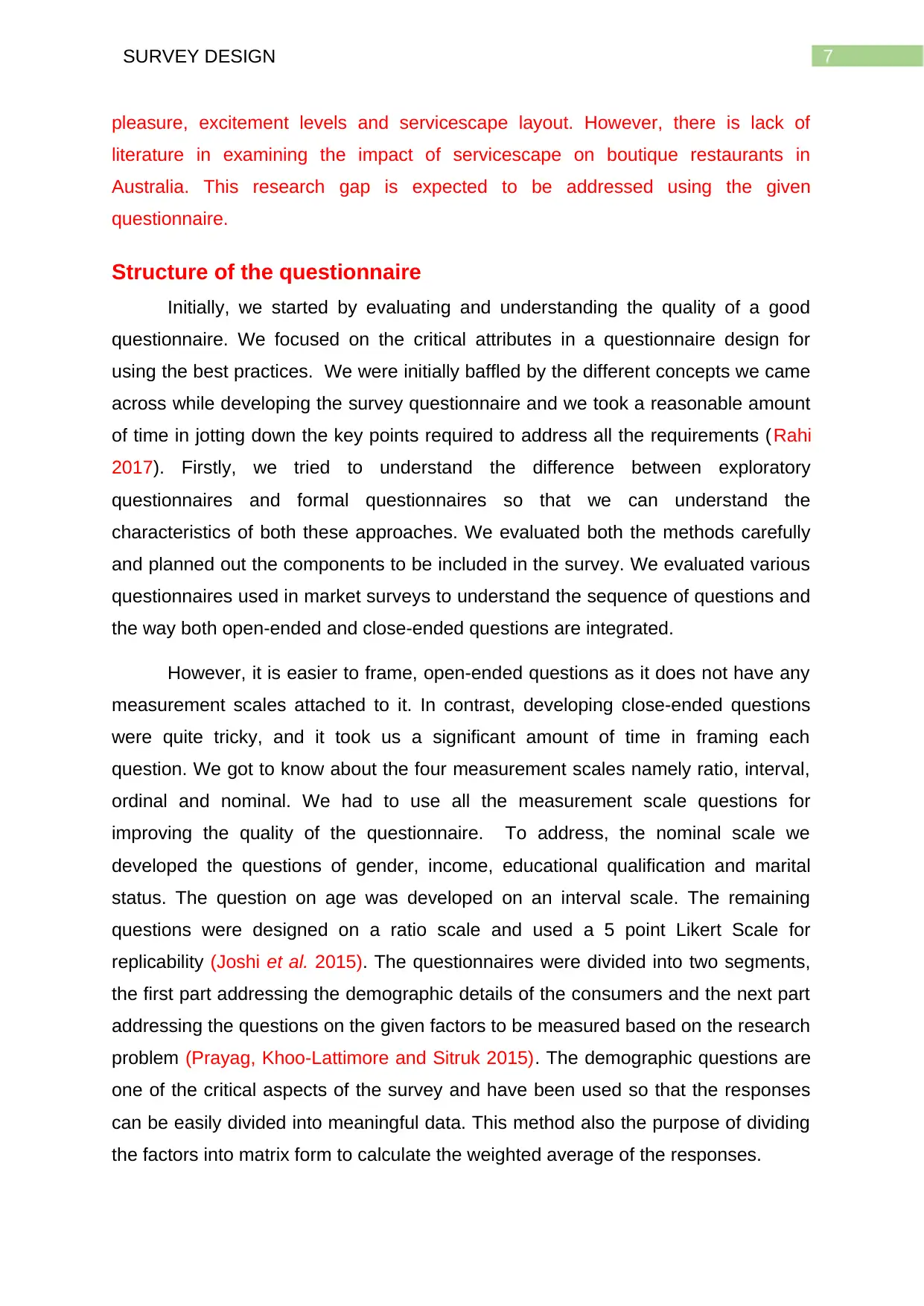
7SURVEY DESIGN
pleasure, excitement levels and servicescape layout. However, there is lack of
literature in examining the impact of servicescape on boutique restaurants in
Australia. This research gap is expected to be addressed using the given
questionnaire.
Structure of the questionnaire
Initially, we started by evaluating and understanding the quality of a good
questionnaire. We focused on the critical attributes in a questionnaire design for
using the best practices. We were initially baffled by the different concepts we came
across while developing the survey questionnaire and we took a reasonable amount
of time in jotting down the key points required to address all the requirements ( Rahi
2017). Firstly, we tried to understand the difference between exploratory
questionnaires and formal questionnaires so that we can understand the
characteristics of both these approaches. We evaluated both the methods carefully
and planned out the components to be included in the survey. We evaluated various
questionnaires used in market surveys to understand the sequence of questions and
the way both open-ended and close-ended questions are integrated.
However, it is easier to frame, open-ended questions as it does not have any
measurement scales attached to it. In contrast, developing close-ended questions
were quite tricky, and it took us a significant amount of time in framing each
question. We got to know about the four measurement scales namely ratio, interval,
ordinal and nominal. We had to use all the measurement scale questions for
improving the quality of the questionnaire. To address, the nominal scale we
developed the questions of gender, income, educational qualification and marital
status. The question on age was developed on an interval scale. The remaining
questions were designed on a ratio scale and used a 5 point Likert Scale for
replicability (Joshi et al. 2015). The questionnaires were divided into two segments,
the first part addressing the demographic details of the consumers and the next part
addressing the questions on the given factors to be measured based on the research
problem (Prayag, Khoo-Lattimore and Sitruk 2015). The demographic questions are
one of the critical aspects of the survey and have been used so that the responses
can be easily divided into meaningful data. This method also the purpose of dividing
the factors into matrix form to calculate the weighted average of the responses.
pleasure, excitement levels and servicescape layout. However, there is lack of
literature in examining the impact of servicescape on boutique restaurants in
Australia. This research gap is expected to be addressed using the given
questionnaire.
Structure of the questionnaire
Initially, we started by evaluating and understanding the quality of a good
questionnaire. We focused on the critical attributes in a questionnaire design for
using the best practices. We were initially baffled by the different concepts we came
across while developing the survey questionnaire and we took a reasonable amount
of time in jotting down the key points required to address all the requirements ( Rahi
2017). Firstly, we tried to understand the difference between exploratory
questionnaires and formal questionnaires so that we can understand the
characteristics of both these approaches. We evaluated both the methods carefully
and planned out the components to be included in the survey. We evaluated various
questionnaires used in market surveys to understand the sequence of questions and
the way both open-ended and close-ended questions are integrated.
However, it is easier to frame, open-ended questions as it does not have any
measurement scales attached to it. In contrast, developing close-ended questions
were quite tricky, and it took us a significant amount of time in framing each
question. We got to know about the four measurement scales namely ratio, interval,
ordinal and nominal. We had to use all the measurement scale questions for
improving the quality of the questionnaire. To address, the nominal scale we
developed the questions of gender, income, educational qualification and marital
status. The question on age was developed on an interval scale. The remaining
questions were designed on a ratio scale and used a 5 point Likert Scale for
replicability (Joshi et al. 2015). The questionnaires were divided into two segments,
the first part addressing the demographic details of the consumers and the next part
addressing the questions on the given factors to be measured based on the research
problem (Prayag, Khoo-Lattimore and Sitruk 2015). The demographic questions are
one of the critical aspects of the survey and have been used so that the responses
can be easily divided into meaningful data. This method also the purpose of dividing
the factors into matrix form to calculate the weighted average of the responses.
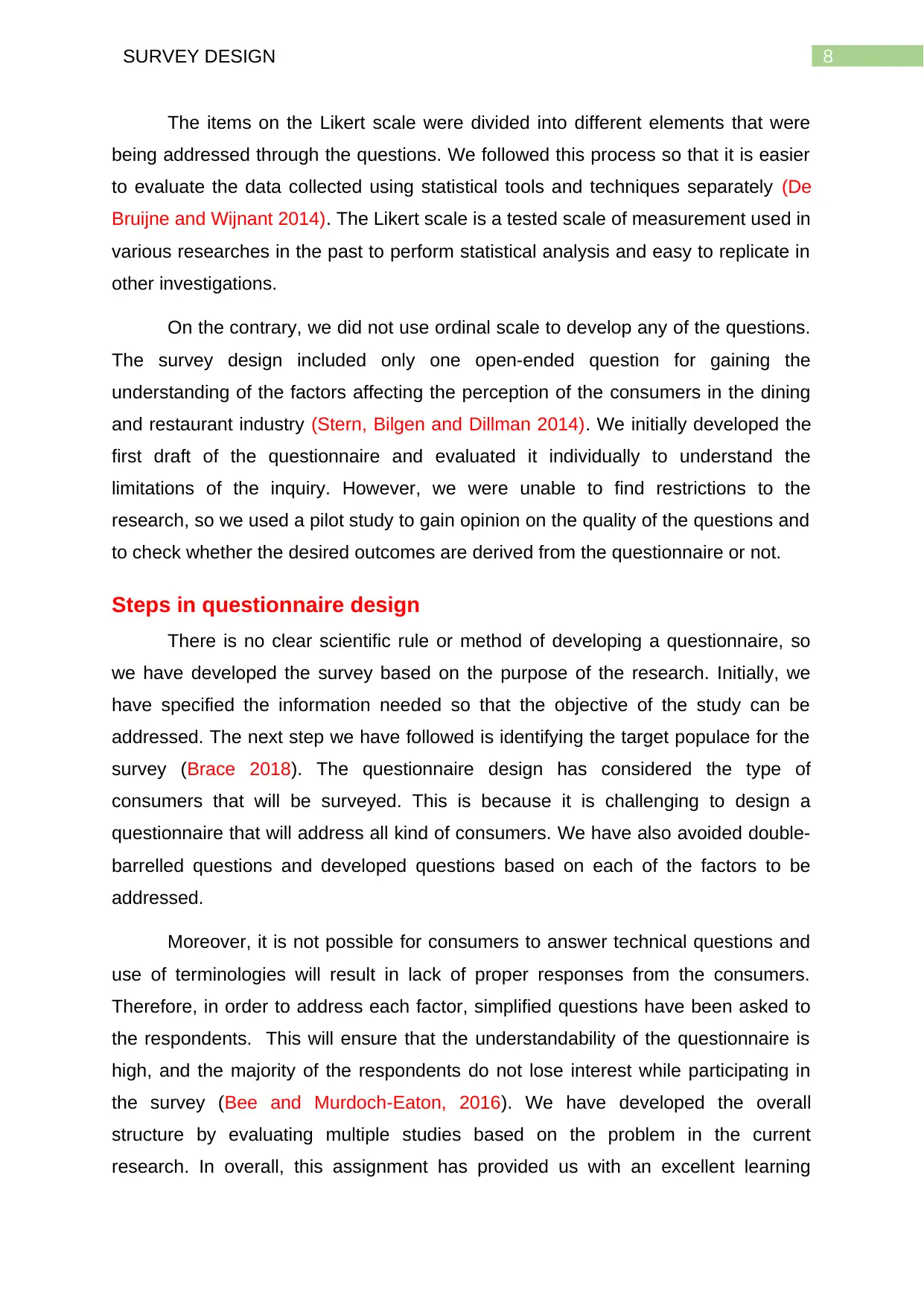
8SURVEY DESIGN
The items on the Likert scale were divided into different elements that were
being addressed through the questions. We followed this process so that it is easier
to evaluate the data collected using statistical tools and techniques separately (De
Bruijne and Wijnant 2014). The Likert scale is a tested scale of measurement used in
various researches in the past to perform statistical analysis and easy to replicate in
other investigations.
On the contrary, we did not use ordinal scale to develop any of the questions.
The survey design included only one open-ended question for gaining the
understanding of the factors affecting the perception of the consumers in the dining
and restaurant industry (Stern, Bilgen and Dillman 2014). We initially developed the
first draft of the questionnaire and evaluated it individually to understand the
limitations of the inquiry. However, we were unable to find restrictions to the
research, so we used a pilot study to gain opinion on the quality of the questions and
to check whether the desired outcomes are derived from the questionnaire or not.
Steps in questionnaire design
There is no clear scientific rule or method of developing a questionnaire, so
we have developed the survey based on the purpose of the research. Initially, we
have specified the information needed so that the objective of the study can be
addressed. The next step we have followed is identifying the target populace for the
survey (Brace 2018). The questionnaire design has considered the type of
consumers that will be surveyed. This is because it is challenging to design a
questionnaire that will address all kind of consumers. We have also avoided double-
barrelled questions and developed questions based on each of the factors to be
addressed.
Moreover, it is not possible for consumers to answer technical questions and
use of terminologies will result in lack of proper responses from the consumers.
Therefore, in order to address each factor, simplified questions have been asked to
the respondents. This will ensure that the understandability of the questionnaire is
high, and the majority of the respondents do not lose interest while participating in
the survey (Bee and Murdoch-Eaton, 2016). We have developed the overall
structure by evaluating multiple studies based on the problem in the current
research. In overall, this assignment has provided us with an excellent learning
The items on the Likert scale were divided into different elements that were
being addressed through the questions. We followed this process so that it is easier
to evaluate the data collected using statistical tools and techniques separately (De
Bruijne and Wijnant 2014). The Likert scale is a tested scale of measurement used in
various researches in the past to perform statistical analysis and easy to replicate in
other investigations.
On the contrary, we did not use ordinal scale to develop any of the questions.
The survey design included only one open-ended question for gaining the
understanding of the factors affecting the perception of the consumers in the dining
and restaurant industry (Stern, Bilgen and Dillman 2014). We initially developed the
first draft of the questionnaire and evaluated it individually to understand the
limitations of the inquiry. However, we were unable to find restrictions to the
research, so we used a pilot study to gain opinion on the quality of the questions and
to check whether the desired outcomes are derived from the questionnaire or not.
Steps in questionnaire design
There is no clear scientific rule or method of developing a questionnaire, so
we have developed the survey based on the purpose of the research. Initially, we
have specified the information needed so that the objective of the study can be
addressed. The next step we have followed is identifying the target populace for the
survey (Brace 2018). The questionnaire design has considered the type of
consumers that will be surveyed. This is because it is challenging to design a
questionnaire that will address all kind of consumers. We have also avoided double-
barrelled questions and developed questions based on each of the factors to be
addressed.
Moreover, it is not possible for consumers to answer technical questions and
use of terminologies will result in lack of proper responses from the consumers.
Therefore, in order to address each factor, simplified questions have been asked to
the respondents. This will ensure that the understandability of the questionnaire is
high, and the majority of the respondents do not lose interest while participating in
the survey (Bee and Murdoch-Eaton, 2016). We have developed the overall
structure by evaluating multiple studies based on the problem in the current
research. In overall, this assignment has provided us with an excellent learning
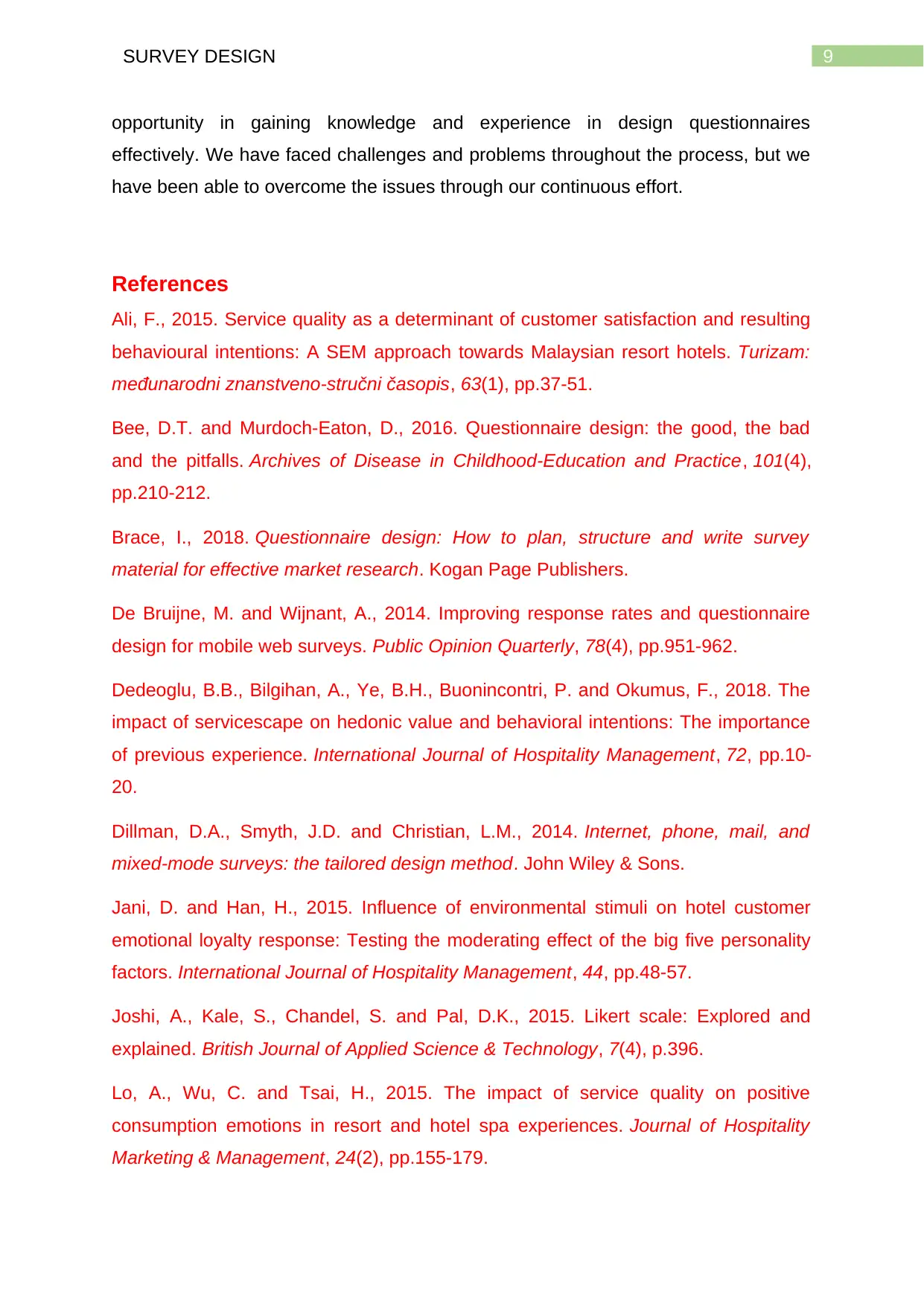
9SURVEY DESIGN
opportunity in gaining knowledge and experience in design questionnaires
effectively. We have faced challenges and problems throughout the process, but we
have been able to overcome the issues through our continuous effort.
References
Ali, F., 2015. Service quality as a determinant of customer satisfaction and resulting
behavioural intentions: A SEM approach towards Malaysian resort hotels. Turizam:
međunarodni znanstveno-stručni časopis, 63(1), pp.37-51.
Bee, D.T. and Murdoch-Eaton, D., 2016. Questionnaire design: the good, the bad
and the pitfalls. Archives of Disease in Childhood-Education and Practice, 101(4),
pp.210-212.
Brace, I., 2018. Questionnaire design: How to plan, structure and write survey
material for effective market research. Kogan Page Publishers.
De Bruijne, M. and Wijnant, A., 2014. Improving response rates and questionnaire
design for mobile web surveys. Public Opinion Quarterly, 78(4), pp.951-962.
Dedeoglu, B.B., Bilgihan, A., Ye, B.H., Buonincontri, P. and Okumus, F., 2018. The
impact of servicescape on hedonic value and behavioral intentions: The importance
of previous experience. International Journal of Hospitality Management, 72, pp.10-
20.
Dillman, D.A., Smyth, J.D. and Christian, L.M., 2014. Internet, phone, mail, and
mixed-mode surveys: the tailored design method. John Wiley & Sons.
Jani, D. and Han, H., 2015. Influence of environmental stimuli on hotel customer
emotional loyalty response: Testing the moderating effect of the big five personality
factors. International Journal of Hospitality Management, 44, pp.48-57.
Joshi, A., Kale, S., Chandel, S. and Pal, D.K., 2015. Likert scale: Explored and
explained. British Journal of Applied Science & Technology, 7(4), p.396.
Lo, A., Wu, C. and Tsai, H., 2015. The impact of service quality on positive
consumption emotions in resort and hotel spa experiences. Journal of Hospitality
Marketing & Management, 24(2), pp.155-179.
opportunity in gaining knowledge and experience in design questionnaires
effectively. We have faced challenges and problems throughout the process, but we
have been able to overcome the issues through our continuous effort.
References
Ali, F., 2015. Service quality as a determinant of customer satisfaction and resulting
behavioural intentions: A SEM approach towards Malaysian resort hotels. Turizam:
međunarodni znanstveno-stručni časopis, 63(1), pp.37-51.
Bee, D.T. and Murdoch-Eaton, D., 2016. Questionnaire design: the good, the bad
and the pitfalls. Archives of Disease in Childhood-Education and Practice, 101(4),
pp.210-212.
Brace, I., 2018. Questionnaire design: How to plan, structure and write survey
material for effective market research. Kogan Page Publishers.
De Bruijne, M. and Wijnant, A., 2014. Improving response rates and questionnaire
design for mobile web surveys. Public Opinion Quarterly, 78(4), pp.951-962.
Dedeoglu, B.B., Bilgihan, A., Ye, B.H., Buonincontri, P. and Okumus, F., 2018. The
impact of servicescape on hedonic value and behavioral intentions: The importance
of previous experience. International Journal of Hospitality Management, 72, pp.10-
20.
Dillman, D.A., Smyth, J.D. and Christian, L.M., 2014. Internet, phone, mail, and
mixed-mode surveys: the tailored design method. John Wiley & Sons.
Jani, D. and Han, H., 2015. Influence of environmental stimuli on hotel customer
emotional loyalty response: Testing the moderating effect of the big five personality
factors. International Journal of Hospitality Management, 44, pp.48-57.
Joshi, A., Kale, S., Chandel, S. and Pal, D.K., 2015. Likert scale: Explored and
explained. British Journal of Applied Science & Technology, 7(4), p.396.
Lo, A., Wu, C. and Tsai, H., 2015. The impact of service quality on positive
consumption emotions in resort and hotel spa experiences. Journal of Hospitality
Marketing & Management, 24(2), pp.155-179.
Secure Best Marks with AI Grader
Need help grading? Try our AI Grader for instant feedback on your assignments.
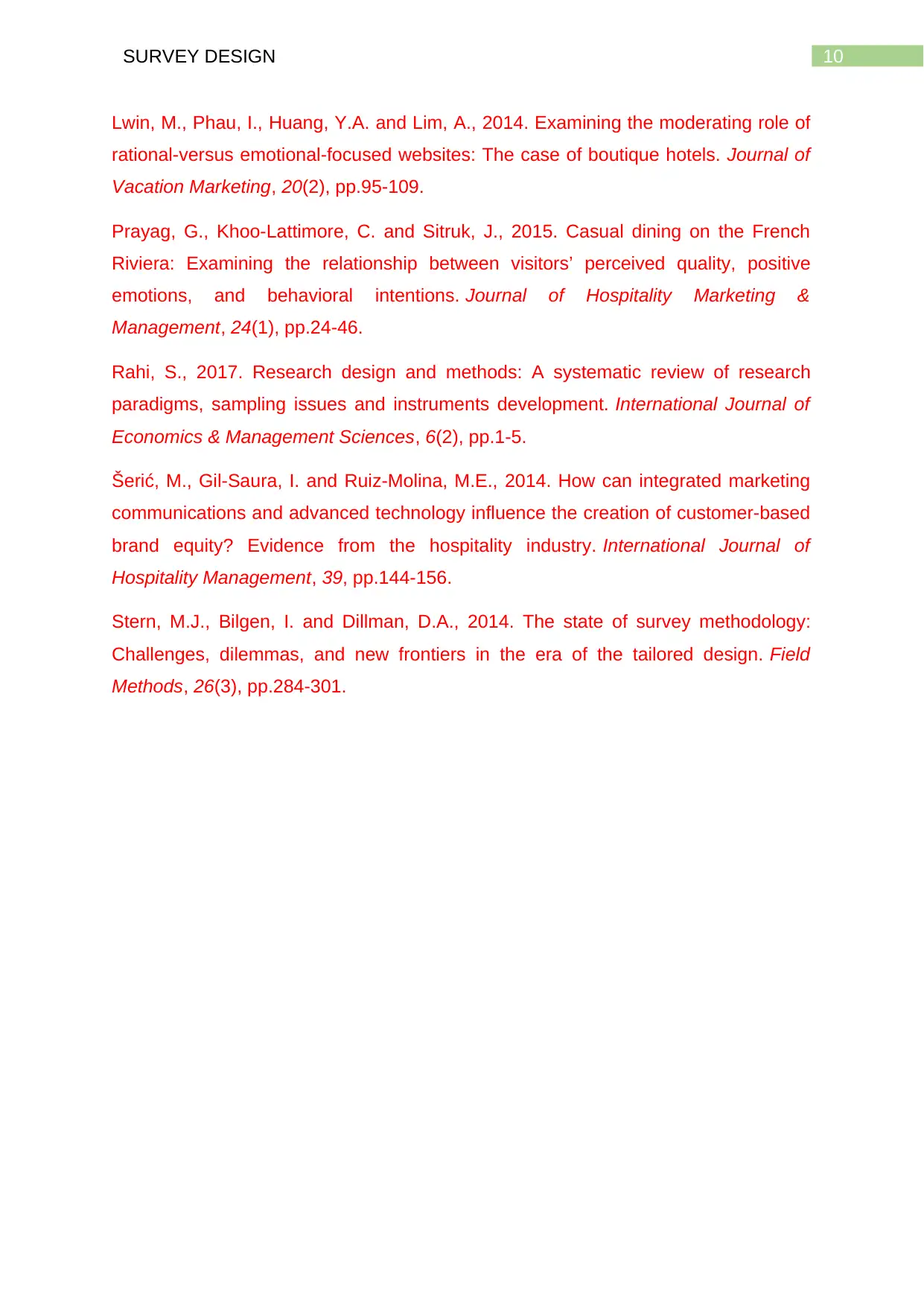
10SURVEY DESIGN
Lwin, M., Phau, I., Huang, Y.A. and Lim, A., 2014. Examining the moderating role of
rational-versus emotional-focused websites: The case of boutique hotels. Journal of
Vacation Marketing, 20(2), pp.95-109.
Prayag, G., Khoo-Lattimore, C. and Sitruk, J., 2015. Casual dining on the French
Riviera: Examining the relationship between visitors’ perceived quality, positive
emotions, and behavioral intentions. Journal of Hospitality Marketing &
Management, 24(1), pp.24-46.
Rahi, S., 2017. Research design and methods: A systematic review of research
paradigms, sampling issues and instruments development. International Journal of
Economics & Management Sciences, 6(2), pp.1-5.
Šerić, M., Gil-Saura, I. and Ruiz-Molina, M.E., 2014. How can integrated marketing
communications and advanced technology influence the creation of customer-based
brand equity? Evidence from the hospitality industry. International Journal of
Hospitality Management, 39, pp.144-156.
Stern, M.J., Bilgen, I. and Dillman, D.A., 2014. The state of survey methodology:
Challenges, dilemmas, and new frontiers in the era of the tailored design. Field
Methods, 26(3), pp.284-301.
Lwin, M., Phau, I., Huang, Y.A. and Lim, A., 2014. Examining the moderating role of
rational-versus emotional-focused websites: The case of boutique hotels. Journal of
Vacation Marketing, 20(2), pp.95-109.
Prayag, G., Khoo-Lattimore, C. and Sitruk, J., 2015. Casual dining on the French
Riviera: Examining the relationship between visitors’ perceived quality, positive
emotions, and behavioral intentions. Journal of Hospitality Marketing &
Management, 24(1), pp.24-46.
Rahi, S., 2017. Research design and methods: A systematic review of research
paradigms, sampling issues and instruments development. International Journal of
Economics & Management Sciences, 6(2), pp.1-5.
Šerić, M., Gil-Saura, I. and Ruiz-Molina, M.E., 2014. How can integrated marketing
communications and advanced technology influence the creation of customer-based
brand equity? Evidence from the hospitality industry. International Journal of
Hospitality Management, 39, pp.144-156.
Stern, M.J., Bilgen, I. and Dillman, D.A., 2014. The state of survey methodology:
Challenges, dilemmas, and new frontiers in the era of the tailored design. Field
Methods, 26(3), pp.284-301.
1 out of 11
Your All-in-One AI-Powered Toolkit for Academic Success.
+13062052269
info@desklib.com
Available 24*7 on WhatsApp / Email
![[object Object]](/_next/static/media/star-bottom.7253800d.svg)
Unlock your academic potential
© 2024 | Zucol Services PVT LTD | All rights reserved.





